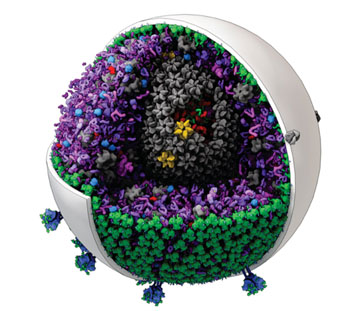Software Visualizes Viruses and Bacteria in 3-D
By LabMedica International staff writers
Posted on 11 Dec 2014
Researchers can now study bacteria, viruses, and the inner workings of the human body with more clarity than ever before with a new software tool.Posted on 11 Dec 2014
In a study published online, ahead of print, in Nature Methods on December 1, 2014, researchers from the Scripps Research Institute (TSRI; La Jolla, CA, USA) demonstrated how the software, cellPACK, can be used to model viruses such as HIV. “We hope to ultimately increase scientists’ ability to target any disease,” said Art Olson, professor at TSRI who is senior author of the new study.

Image: cellPACK software can generate models of midsized structures, such as this one of HIV (Photo courtesy of Scripps Research Institute).
The cellPACK software answers a major hurdle in structural biology. Although scientists have developed techniques to study comparatively large structures, such as cells, and very small structures, such as proteins, it has been harder to visualize structures in the medium “mesoscale” range.
With cellPACK, researchers can quickly and efficiently process the data they have gathered on smaller structures to construct models in this mid-size range. Earlier, researchers had to create these models by hand, which took weeks or months compared with just hours in cellPACK.
As a demonstration of the software’s power, the researchers of the new study created a model of HIV revealing how outer “spike” proteins are dispersed on the surface of the immature virus. The new model put to the test a conclusion made by HIV researchers from super-resolution microscopic studies—that the distribution of the spike proteins on the surface of the immature virus is random. But by using cellPACK to generate thousands of models, testing other hypotheses, the researchers discovered that the distribution was not random. “We demonstrated that their interpretation of the distribution did not match that hypothesis,” said Dr. Olson.
The cellPACK software began as the thesis project of a TSRI graduate student, Graham Johnson, now a QB3 faculty fellow at the University of California, San Francisco (UCSF) who continues to contribute to the project. Mr. Johnson had more 15 years’ experience as a medical illustrator, and he wanted to create an easy way to visualize mesoscale structures. cellPACK is an expansion of Mr. Johnson’s autoPACK software, which maps out the density of substances—from concrete in a building to red blood cells in an artery. The researchers noted that cellPACK is a community effort, and they have made the autoPACK and cellPACK software free and open source; the software is available online (Please see related links below).
“With the creation of cellPACK, Dr. Olson and his colleagues have addressed the challenge of integrating biological data from different sources and across multiple scales into virtual models that can simulate biologically relevant molecular interactions within a cell,” said Veerasamy Ravichandran, PhD, of the US National Institutes of Health’s (NIH) National Institute of General Medical Sciences (Bethesda, MD, USA), which partially funded the research. “This user-friendly tool provides a new platform for data analysis and simulation in a collaborative manner between laboratories.”
As new information comes in from the scientific community, researchers will tweak the software so it can model new shapes. “Making it open source makes it more powerful,” said Dr. Olson. “The software right now is usable and very useful, but it’s really a tool for the future.”
The Scripps Research Institute (TSRI) is one of the world’s largest independent, not-for-profit organizations focusing on research in the biomedical sciences. TSRI is internationally recognized for its contributions to science and health, including its role in laying the foundation for new treatments for cancer, rheumatoid arthritis, hemophilia, and other disorders.
Related Links:
Scripps Research Institute
cellPACK software













